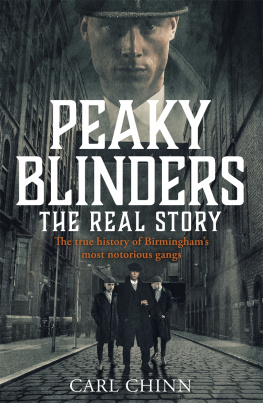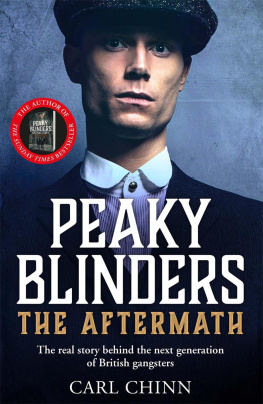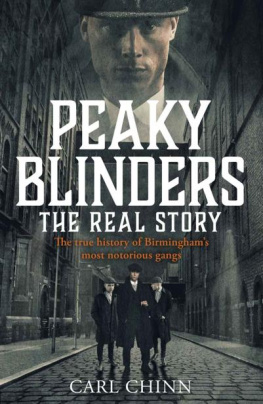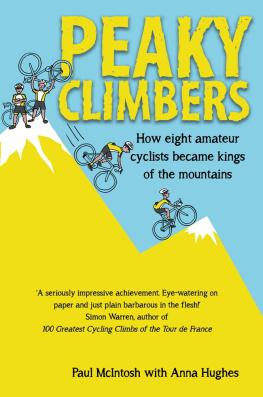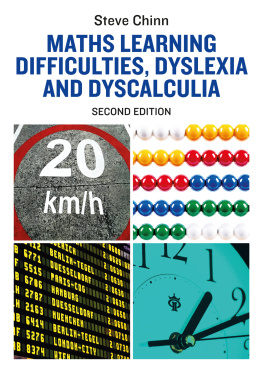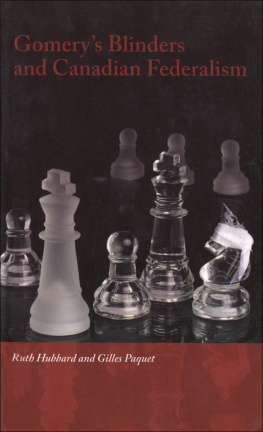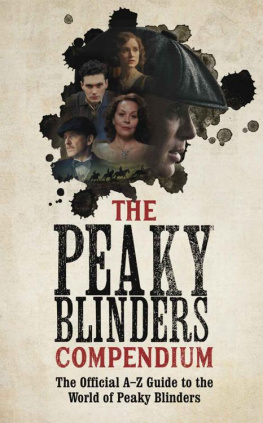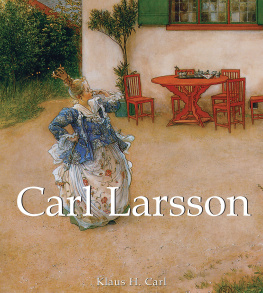Carl Chinn - Peaky Blinders: The Legacy
Here you can read online Carl Chinn - Peaky Blinders: The Legacy full text of the book (entire story) in english for free. Download pdf and epub, get meaning, cover and reviews about this ebook. year: 2020, publisher: John Blake, genre: Detective and thriller. Description of the work, (preface) as well as reviews are available. Best literature library LitArk.com created for fans of good reading and offers a wide selection of genres:
Romance novel
Science fiction
Adventure
Detective
Science
History
Home and family
Prose
Art
Politics
Computer
Non-fiction
Religion
Business
Children
Humor
Choose a favorite category and find really read worthwhile books. Enjoy immersion in the world of imagination, feel the emotions of the characters or learn something new for yourself, make an fascinating discovery.
- Book:Peaky Blinders: The Legacy
- Author:
- Publisher:John Blake
- Genre:
- Year:2020
- Rating:3 / 5
- Favourites:Add to favourites
- Your mark:
- 60
- 1
- 2
- 3
- 4
- 5
Peaky Blinders: The Legacy: summary, description and annotation
We offer to read an annotation, description, summary or preface (depends on what the author of the book "Peaky Blinders: The Legacy" wrote himself). If you haven't found the necessary information about the book — write in the comments, we will try to find it.
Carl Chinn: author's other books
Who wrote Peaky Blinders: The Legacy? Find out the surname, the name of the author of the book and a list of all author's works by series.
Peaky Blinders: The Legacy — read online for free the complete book (whole text) full work
Below is the text of the book, divided by pages. System saving the place of the last page read, allows you to conveniently read the book "Peaky Blinders: The Legacy" online for free, without having to search again every time where you left off. Put a bookmark, and you can go to the page where you finished reading at any time.
Font size:
Interval:
Bookmark:


Professor Carl Chinn, MBE, PhD, is a social historian, writer, public speaker, and teacher. An off-course bookmaker himself until 1984, he is the son and grandson of illegal bookmakers in Sparkbrook, whilst his mothers family were factory workers in Aston. His writings are deeply affected by his familys working-class background and life in the back-to-backs of Birmingham, and have earned him a national following. He believes passionately that history must be democratised because each and every person has made their mark upon history and has a story to tell. Peaky Blinders: The Real Story is his thirty-third book.

First published in the UK by John Blake Publishing
An imprint of Bonnier Books UK
80-81 Wimpole Street, London, W1G 9RE
Owned by Bonnier Books
Sveavgen 56, Stockholm, Sweden
www.facebook.com/johnblakebooks 
twitter.com/jblakebooks 
First published in paperback in 2020
Paperback: 978-1-78946-293-7
Ebook: 978-1-78946-294-4
Audio: 978-1-78946-311-8
All rights reserved. No part of this publication may be reproduced, stored in a retrieval system, or transmitted in any form or by any means, without the prior permission in writing of the publisher, nor be otherwise circulated in any form of binding or cover other than that in which it is published and without a similar condition including this condition being imposed on the subsequent purchaser.
British Library Cataloguing-in-Publication Data.
A catalogue record for this book is available from the British Library.
Design by www.envydesign.co.uk
1 3 5 7 9 10 8 6 4 2
Text copyright Carl Chinn 2020
The right of Carl Chinn to be identified as the author of this work has been asserted by him in accordance with the Copyright, Designs and Patents Act 1988.
Every reasonable effort has been made to trace copyright-holders of material reproduced in this book, but if any have been inadvertently overlooked the publishers would be glad to hear from them.
John Blake Publishing is an imprint of Bonnier Books UK
www.bonnierbooks.co.uk

CONTENTS

THE PEAKY BLINDERS LEGACY
The Roaring Twenties of the popular imagination is an exuberant, joyous, fashionable and, above all, youthful decade encapsulated by the self-indulgent Bright Young Things. A mixture of rich aristocrats and bohemians disdainful of social norms, they delighted in their wild behaviour, spectacular parties, expensive cocktails, drug-taking and outrageous excesses. This impression of the 1920s is infused with the riches and privilege of a tiny minority, yet the decade was an exciting one for many more who relished new-found freedoms. Released from their stays and hoops, young women known as flappers went out more confidently in skirts shortened to the knee and with bobbed hair covered trendily by bell-shaped cloche hats worn low on the forehead. Smoking and drinking like young men, they too embraced the jazz craze, the dance craze, the cinema craze, the Charleston craze and all the other crazes of the decade.
As for the middle-aged middle class, the 1920s may not have been roistering but they were pleasurable. Growing in numbers and secure in their employment, they could afford to buy modern semi-detached houses in the suburbs and to spend their disposable income on the cars that took them to and from work and on day trips. Yet millions faced a harsher reality. Britain was riven by gender and class inequalities. Working-class women may have gained the vote in 1928 but they were far from equal in education, health, the workplace and opportunities; huge numbers of working-class people still lived in badly built and overcrowded housing in polluted neighbourhoods; and working-class men were much more likely than others to suffer the indignities and hopelessness of unemployment. The older industries that had propelled Britain into industrial supremacy were in rapid decline, and the closure of cotton mills, iron works, coal mines and shipyards devastated whole communities across Britain. In a land of plenty, unhappily the only abundant thing in the lives of the poor was poverty. The Roaring Twenties may have been a party-time for a few, but for countless numbers it was a hard and hungry time.
These grim realities are ignored in dramatised versions of the decade, which are also deeply affected by Hollywoods portrayals of Jazz Age America with its mobsters and their molls, singers, dancers, bootleggers, decadent socialites, speakeasies, shootouts, and escapades. Gangsters, in particular, have become ingrained in the popular consciousness as a peculiarly 1920s American phenomenon, but more recently a stylish, peak-capped and charismatic British version has arisen through the acclaimed television series, Peaky Blinders. These gangsters take their name from real peaky blinders, who also wore flat caps, but, unlike their fictional counterparts, they were neither well-dressed nor alluring. Vicious thugs, they had made Birmingham notorious as one of the most violent cities in Britain, not in the 1920s but in the late nineteenth and early twentieth centuries. Belonging to numerous street gangs, they revelled in fighting each other, attacking the police and preying upon the decent majority of the poor amongst whom they lived.
As explored in Peaky Blinders: The Real Story, they disappeared before the First World War, thanks to stronger policing, sterner sentences for violent crime and the provision of youth and sports clubs for lads. Yet though their reign of ruffianism was ended in Birmingham, they passed on a violent legacy because men who had been peaky blinders sparked the first major gangland war in Britain. Belonging to a loose combination of villains known as the Birmingham Gang, by 1920, they controlled the pickpocketing of racegoers and the blackmailing of bookmakers on most of Englands racecourses. Such criminality was lucrative and the Birmingham Gangs dominance was quickly challenged in the South by Londons Sabini Gang. The resulting Racecourse War of the spring and summer of 1921 was a new and shocking phenomenon. Previously, street gangs within one city had brawled with each other simply to assert which was the hardest; now, two gangs of criminals from different cities clashed over making money illegally. The fighting between them was brutal, provoking headlines in newspapers across the country. Men were scarred by slashes from cut-throat razors; others were shot; and many were battered with hammers and other weapons. And at the forefront of the fighting were former peaky blinders.
During their heyday in the 1890s, it was noticed that senior peaky blinders had become racecourses rogues, travelling the country during the more thrilling Flat racing season of the spring and summer.
Racecourse pests, as the police termed them, were known colloquially as the Boys, and the Birmingham Boys, also called the Brummagem Boys, ranged wide, but they were not alone. In Scotland, crews of roughs from the East End of Glasgow and other notorious regions were foremost in a reprehensible system that had been in vogue at Scottish race meetings for a considerable time forcing money from bookmakers.
Next pageFont size:
Interval:
Bookmark:
Similar books «Peaky Blinders: The Legacy»
Look at similar books to Peaky Blinders: The Legacy. We have selected literature similar in name and meaning in the hope of providing readers with more options to find new, interesting, not yet read works.
Discussion, reviews of the book Peaky Blinders: The Legacy and just readers' own opinions. Leave your comments, write what you think about the work, its meaning or the main characters. Specify what exactly you liked and what you didn't like, and why you think so.


